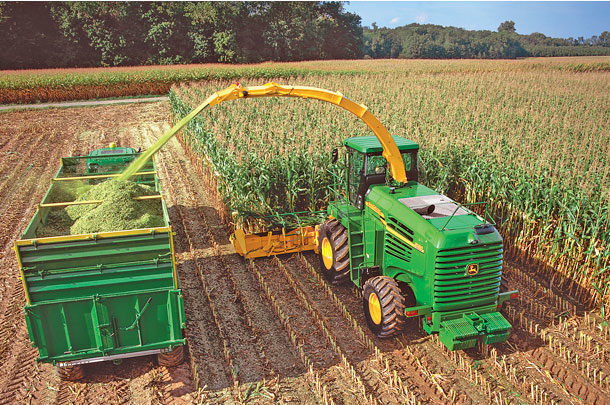In the field, forage crops are naturally colonized by many types of micro-organisms, some being beneficial and others detrimental to the ensiling process. Therefore, inoculating fresh forage with fast-growing, effective lactic acid bacteria (LAB) is recommended to maximize the retention and preservation of nutrients and dry matter (DM) in the resulting silage.
Most independent advisers agree research-proven forage inoculants are a key part of the overall management package required to produce high-quality silages. Furthermore, bacterial-based forage inoculants are safe, non-corrosive and an environment-friendly choice.
The use of a forage inoculant is a relatively inexpensive investment, but it is absolutely not a substitute for good management. Remember, the resulting quality of the silages depends directly on the quality at harvest and the management practices applied during ensiling, storage and feedout.
Drop the pH, fast
Traditional inoculants contain species of LAB that convert soluble sugars to lactic acid only and are known as “homolactic” bacteria; some common species include Lactobacillus plantarum and Pediococcus pentosaceus. This type of inoculant drives fermentation with no wasteful side products and results in high recoveries of DM and nutrients, while also helping to prevent uncontrolled and undesirable natural fermentations that convert forage DM into carbon dioxide, which is lost to the atmosphere, as it is a gas, and potentially negative products such as butyric acid.
Lactic acid is approximately 10 times stronger than the other acids produced during ensiling (acetic and propionic), and therefore it is the most efficient acid for a rapid pH drop. The low pH produced in the silage will effectively “pickle” the forage and inhibits plant enzymes that break down proteins and digestible fiber. The low pH also inhibits undesirable microbes like clostridia and enterobacteria, which lead to high DM loss, and these bacteria may produce compounds harmful to the animal, e.g., butyric acid, biogenic amines, etc.
The recognized effective application rate for proven homolactic-only inoculants is 100,000 colony-forming units (CFU) per gram of forage. Homolactic inoculants are recommended in all ensiling situations, even when feed stability in storage and in the feedbunk are not an issue. Legume crops and wet forage crops harvested at less than 32 percent DM should always be inoculated with a homolactic inoculant.
The protein and mineral content in legumes coupled with the high forage moisture content will require more acid to be produced in order to pickle the silage. If these challenges are not properly addressed, it can easily lead to the growth of clostridia, associated with protein degradation and butyric acid production, resulting in material that can be unsafe to feed. Remember, you can always manage fermentation to help make good fermentation better.
Keeping silage stable
Another class of forage inoculants available on the market help improve the aerobic and feedout stability of silage by preventing dry matter/energy losses and heating in the silage mass or feedbunk. The bacteria in this type of inoculant produce compounds with strong antimicrobial properties in addition to the lactic acid required for the initial pH drop – in fact, lactic acid can be a food source for the yeasts that cause aerobic spoilage, which is why we need to add these bacteria along with the homolactics.
Propionibacteria are capable of producing propionic and acetic acids, which help inhibit the growth of spoilage yeasts and other undesirable microbes. However, due to its relatively low acid tolerance, better responses of inoculation with an inoculant containing propionibacteria have been reported in haylages and high-moisture corn (HMC), which naturally have a slow decline in pH.
Lactobacillus buchneri is a heterofermentative LAB proven effective in enhancing the shelf life not only of silages and HMC but also of TMRs made with preserved feeds. L. buchneri slowly converts moderate amounts of lactic acid – produced during early fermentation – to acetic acid, a strong anti-fungal compound. Notably, the specific strain L. buchneri 40788 is the only inoculant active that has been reviewed by the FDA and allowed to claim improved aerobic stability, which is linked to higher application rates (e.g., 400,000 CFU per gram for silage, 600,000 CFU per gram for high-moisture corn).
While spoilage yeasts are directly responsible for virtually all the heating events in silages and HMC, controlling their population also has a significant impact on inhibiting the development of opportunistic spoilage micro-organisms. Typically, after yeasts have destabilized silage and raised the pH, molds and bacteria can grow, resulting in a highly spoiled and potentially hazardous feed.
Proven products that will reliably prevent aerobic spoilage tend to be more expensive than homolactic inoculants – no need to pay if there is no need. So you need to strategize where to make the extra investment. Is there a history of silage or TMR heating at your operation? Is the forage to be ensiled likely to be more prone to aerobic spoilage? Is the crop overly mature with high levels of fermentable carbohydrates (corn silage, HMC)? Did the DM get away from you, making the crop more difficult to pack?
Was there field damage due to insects or fungal disease, hail or frost? Was there drought stress or flood exposure? Will there be a slow feedout rate or is the silage relocated before feeding? If yes to any of these questions, then consider products containing bacteria proven to improve aerobic stability. The higher investment is worth it, proactively addressing these situations rather than using pounds of buffered propionic acid at the time of feedout.
Combination inoculants – the best of both worlds
L. buchneri has marginal effect during active fermentation; thus, there are products combining L. buchneri with homolactic bacteria. Combination inoculants both control the initial ensiling fermentation and keep feed stable through feeding. They have been proven in independent trials across a wide range of materials including haylages, corn silages, HMC, earlage, snaplage, small grains, drier alfalfa, grass haylages, etc.
Do the math; inoculants pay
There are a wide range of microbial forage inoculants available in the market. Look for a product that contains bacterial strains whose effectiveness was tested by independent research institutions and published in peer-reviewed papers. Research-proven products indicate the assurance of the supplier to prove a high product quality and value. Also, some companies go further by providing technical experts to help build detailed silage management plans to help ensure the quality of silages produced, so consider the “package” that can be offered.
Look cautiously for information on the label regarding the bacterial counts, strain identification numbers (linked to the research), guaranteed viability, shelf life and enzyme activity. Additionally, freeze-dried bacteria are highly sensitive to moisture, so make sure your supplier addresses those potential hurdles with the product formulation, packaging and quality control and assurance programs.
The take-home messages
Find out what your needs are and decide on the best-fit inoculant (and service). If you are employing a custom harvester, make sure the product will be stored properly and applied correctly and the cost is defined. Keep in mind, you will get the best results out of the inoculant by starting with forage harvested at the appropriate stage of maturity and DM content, and managing the phases of ensiling – harvest, storage and feedout.
You need to start with top-quality forage crops; practice good management and use proven forage inoculants as key parts of that overall program, not a “magic bullet.” ![]()
PHOTO: Forage inoculants are a relatively inexpensive way to produce high-quality forages, but they are by no means a susbtitute for good management. Photo courtesy of Lallemand.
Bob Charley has a Ph.D. in applied microbiology from the University of Strathclyde in Glasgow, Scotland. Renato Schmidt has a doctorate in animal nutrition from the University of Delaware and is employed by Lallemand Animal Nutrition as a forage products specialist.











